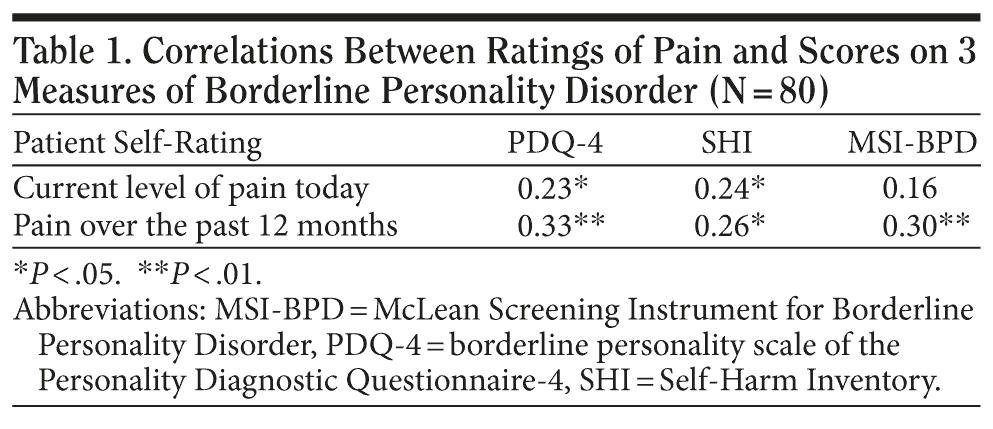The Relationship Between Self-Reported Pain and Borderline Personality Symptomatology Among Internal Medicine Outpatients
To the Editor: The history of the investigation of the pain experience in borderline personality disorder (BPD) is a seemingly paradoxical one, with earlier studies focusing on the underexperiencing of pain and more recent studies focusing on the overexperiencing of pain.1 With regard to the overexperiencing of pain, Harper stated that “the borderline patient’s tolerance of [pain] discomfort will typically be of shorter duration than other individuals”2(p197)—an observation that is supported by several studies3-5 but not others.6,7
In the following study, we examined relationships between borderline personality symptomatology (BPS) and the perception of pain status on the day of participation and pain status over the past 12 months. We hypothesized that participants with higher levels of BPS would evidence significant associations with the 2 study variables.
Method. Participants were both men and women, aged 18 to 65 years, who presented for outpatient treatment in an internal medicine setting from May 1, 2007, through June 30, 2009. Exclusion criteria were cognitive, medical, psychiatric, and/or intellectual impairment that would preclude the successful completion of a survey booklet. A total of 82 patients were approached; 80 agreed to participate (response rate of 97.6%).
The sample consisted of 21 men and 59 women (N = 80), who ranged in age from 18 to 74 years (mean = 45.58 years, SD = 14.74 years). The large majority were white (89.9%). With regard to education, 20.3% had not graduated from high school, 41.8% had graduated from high school, and 8.9% had a bachelor’s degree.
Two resident physicians in the Department of Internal Medicine at Kettering Medical Center (Dayton, Ohio) recruited subjects from their patient caseloads as clinical demands allowed (a sample of convenience). Each participant was asked to complete a survey booklet (the cover page contained the elements of informed consent).
In the survey booklet, we initially explored demographic information. We next explored pain levels, both “today” and “over the past 12 months,” from 0 (no pain) to 10 (highest level of imaginable pain). We then explored BPS using 3 self-report measures: the borderline personality scale of the Personality Diagnostic Questionnaire-4,8 the Self-Harm Inventory,9 and the McLean Screening Instrument for Borderline Personality Disorder.10
This project was approved by the institutional review boards of both the community hospital and the university.
Results. Correlations between participant self-ratings of pain levels and their scores on each of the 3 measures of BPD are presented in Table 1. Note that there were statistically significant correlations between pain, both current and past 12 months, and most measures (5/6) of BPS.
Self-ratings of current and 12-month pain levels demonstrated statistically significant relationships with the majority of the measures for BPS, suggesting that patients with BPS in primary care settings may overexperience pain. This study has a number of potential limitations, including the use of self-report study measures (hence the use of the term BPS rather than BPD), a relatively small sample size, and use of a sample of convenience. However, this is the first study to our knowledge to determine self-reported acute and semichronic pain assessments using 3 measures of BPD. Only further research will clarify the nuances of this relationship.
References
1. Sansone RA, Sansone LA. Borderline Personality in the Medical Setting. Unmasking and Managing the Difficult Patient. New York, NY: Nova Science; 2007:63-86.
2. Harper RG. Borderline personality. In: Harper RG, ed. Personality-Guided Therapy in Behavioral Medicine. Washington, DC: American Psychological Association; 2004:179-205.
3. Sansone RA, Whitecar P, Meier BP, et al. The prevalence of borderline personality among primary care patients with chronic pain. Gen Hosp Psychiatry. 2001;23(4):193-197. PubMed doi:10.1016/S0163-8343(01)00148-7
4. Frankenburg FR, Zanarini MC. The association between borderline personality disorder and chronic medical illnesses, poor health-related lifestyle choices, and costly forms of health care utilization. J Clin Psychiatry. 2004;65(12):1660-1665. PubMed doi:10.4088/JCP.v65n1211
5. Zanarini MC, Barison LK, Frankenburg FR, et al. Family history study of the familial coaggregation of borderline personality disorder with Axis I and nonborderline dramatic cluster Axis II disorders. J Pers Disord. 2009;23(4):357-369. PubMed doi:10.1521/pedi.2009.23.4.357
6. Sansone RA, Pole M, Dakroub H, et al. Childhood trauma, borderline personality symptomatology, and psychophysiological and pain disorders in adulthood. Psychosomatics. 2006;47(2):158-162. PubMed doi:10.1176/appi.psy.47.2.158
7. Sansone RA, Sinclair JD, Wiederman MW. Borderline personality among outpatients seen by a pain management specialist. Int J Psychiatry Med. 2009;39(3):341-344. PubMed doi:10.2190/PM.39.3.i
8. Hyler S. Personality Diagnostic Questionnaire-4 (PDQ-4). New York, NY: New York State Psychiatric Institute; 1995.
9. Sansone RA, Wiederman MW, Sansone LA. The Self-Harm Inventory (SHI): development of a scale for identifying self-destructive behaviors and borderline personality disorder. J Clin Psychol. 1998;54(7):973-983. PubMed doi:10.1002/(SICI)1097-4679(199811)54:7<973::AID-JCLP11>3.0.CO;2-H
10. Zanarini MC, Vujanovic AA, Parachini EA, et al. A screening measure for BPD: the McLean Screening Instrument for Borderline Personality Disorder (MSI-BPD). J Pers Disord. 2003;17(6):568-573. PubMed doi:10.1521/pedi.17.6.568.25355
Author affiliations: Wright State University School of Medicine, Dayton, Ohio (Dr Sansone); Kettering Medical Center, Kettering, Ohio (Drs Sansone, Mueller, and Mercer); and Department of Human Relations, Columbia College, Columbia, South Carolina (Dr Wiederman).
Potential conflicts of interest: None reported.
Funding/support: There was no external funding for this project.
Published online: September 23, 2010 (doi:10.4088/PCC.09l00933whi)
Prim Care Companion J Clin Psychiatry 2010;12(5):e1
© Copyright 2010 Physicians Postgraduate Press, Inc.



